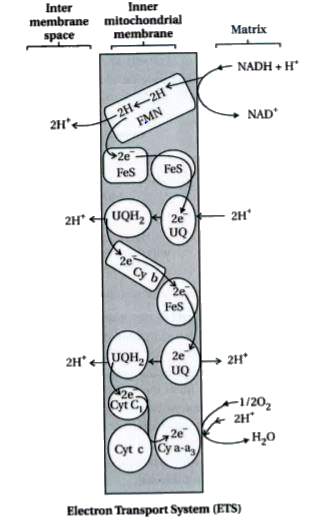Describe the reaction occuring in membrane of Cristae of mitochondria .
Text Solution
The following steps in the respiratory process are to release and utilise the energy stored in NADH+H+andFADH2
This is accomplished when they are oxidised through the electron transport system and the electrons are passed on to O2 resulting in the formation of H2O
The metabolic pathway through which the electron passes form one carrier to another is called the electron transport system .(ETS)
It is present in the inner mitochondrial membrane .
Electrons from NADH produced in the mitochondrial matrix during citric acid cycle are oxidised by an NADH dehydrogenase (Complex-I).
Electrons are then transferred to ubiquinonc location within the inner membrane.
Ubiquinone also receives reducing equivalents via FADH2 (Complex -II)
That is generated during oxidation of succinate in the citric acid cycle.
The reduced ubiquinone is then oxidised with the transfer of electrons to cytochrome c via cytochrome bc1 complex (Complex - III)
Cytochrome c is small protein attached to the other surface to the inner membrane and acts as a mobile carrier for transfer of electrons between complex III and IV .
Complex IV refers to cytochrome c oxidase complex containing cytochromes a and a3 and two copper centers.

ATP formation in ETS :
When the electrons pass form one carrier to another via complex I to IV in the electron transport chain, they are coupled to ATP synthase (complex V) for the production of ATP from ADP and inorganic phosphate.
The number of ATP molecules synthesised depends on the nature of the electron donor.
Oxidation of one molecule of NADH gives rise to 3 molecules of ATP, while that of one molecule of FADH2 produces 2 molecules of ATP.
Although the aerobic of respiration takes place only in the presences of oxygen .
The role of oxygen is limited tot he terminal stage of the process. Yet the presence of oxygen is vital, since it drives the whole process by removing hydrogen form the system .
Oxygen acts as the final hydrogen accepter . (For production ofH2 O)
In respiration it is the energy of oxidation-reduction utilised for the same process . it is for this reason that the process is called oxidative phosphorylation .
|
Topper's Solved these Questions
- RESPIRATION IN PLANTSBOOK - KUMAR PRAKASHANCHAPTER - RESPIRATION IN PLANTSEXERCISE - Section - B (Difference /Scientific Reasons )
7 Videos
- RESPIRATION IN PLANTSBOOK - KUMAR PRAKASHANCHAPTER - RESPIRATION IN PLANTSEXERCISE - Section - C (Location-Function /Full Name / Formulas)
26 Videos
- PLANT KINGDOMBOOK - KUMAR PRAKASHANCHAPTER - PLANT KINGDOMEXERCISE - OBJECTIVE SECTION (FILL IN THE BLANKS)
9 Videos
- SAMPLE QUESTION PAPER FOR ANNUAL EXAMBOOK - KUMAR PRAKASHANCHAPTER - SAMPLE QUESTION PAPER FOR ANNUAL EXAMEXERCISE - SECTION - D
2 Videos
Similar Questions
Knowledge Check
Outer and inner membranes of mitochondria are
AStructurally and functionally similarBStructurally and functionally dissimilarCStructurally similar but functionally differentDStructurally different but functionally similar.Folding of inner membrane of mitochondria are called
ACristaeBGranaCCalcium oxalate crystalsDSacsInner membrane of mitochondria is permeable to
AglucoseBfructoseCsucroseDATP
